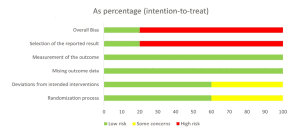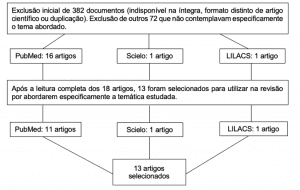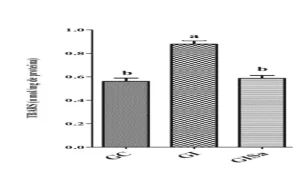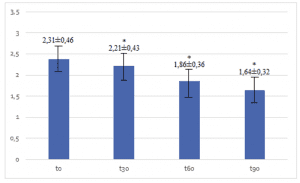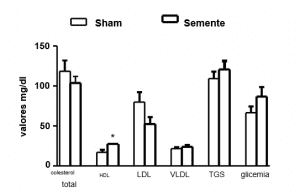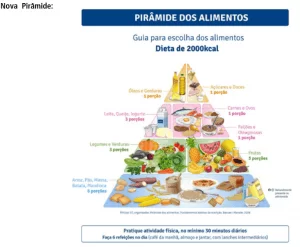DAMANN, Iasmin [2]
DAMANN, Iasmin. Preserved in Natura. Multidisciplinary Core scientific journal of knowledge. 03 year, Ed. 06, vol. 06, pp. 41-67, June 2018. ISSN:2448-0959
Summary
Preserved were discovered by man for thousands of years, since that time the greatest difficulty encountered was how to save and store your food for longer keeping its features intact, do not count with the equipment technology found nowadays. Along with the discovery of the methods of preserving food were made without any theoretical knowledge, but rather simulating natural processes that used the smoke and the Sun, with these simulations also came to the conclusion that natural some fruits were kept preserved by sugar, and some greenery for the vinegar and placed in a sealed container could solve the problem with the food degradavam in time without any conservation, so preserve it would be known later on. After the knowledge of retains many onlookers decided to delve to learn more of the origin and the method used, causing many developed methods of most current conservation and safe for the production and marketing of preserves. This work was done with bibliographical research and on the spot, in a small family agribusiness company in the municipality of Vila Nova in Rio Grande do Sul. With this research was able to see and understand how the canning process on a large scale, observing hygiene care and handling, because it will be sold to other people, since it is distinguished from homemade process There is a lot of knowledge of the risks of contamination. It is concluded that since your discovery and your improvement, saves space on the market, which gained acceptance keeps growing. In this scenario of canning, agribusiness way shy figure family, which should be different, because the final product retains its nutritional values and organoleptic properties intact. The recognition is your little valued, and this is directly related to the choice of the final consumer, who opts for natural because you know that the product has been produced in the field for farmers and their families, with no industrialization. Anyway, it's an area that lacks investments and incentives for your expansion and development.
Keywords: Preserves, conservation, food.
Introduction
The discovery of preserved was made even in antiquity. The man needed some way to maintain and conserve their food longer, regardless of the climate that would affect the food stocked. Based on the discovery of cooking and the use of salt (NaCl) and water, realized that there would have the solution to your problems, so the discovery of the first preserved in natura. Over the years something new was created and reinvented and that produced the existing preserves until today, with several varieties of vegetables and fruits, using the discovery of vinegar and sugar, that time would not have access, stored in glass all sizes (KROLOW, 2006).
To obtain a product of quality and safety, regardless of whether the process is artisanal or industrialized, there are three important factors: quality of the raw material used, appropriate technology, and the correct manipulation. For the preparation of preserved vegetables, is of paramount importance the use of raw materials produced in the field of quality, a correct execution of the handler on the good manufacturing practices (GMP), as well as the knowledge to develop the process of conservation in appropriate temperatures (KROLOW, 2006).
The present research aims to inform about the discovery of preserved, compare between natural food and industrialized food which the consumer view on these factors demonstrate the manufacturing process in on-the-spot research, recognize and enhance the family agriculture an industry that is still little known.
1. Theoretical framework
1.1 Preserves
Pickled vegetable is the product named with edible parts of vegetables, defined in these potted standards, virtually raw, rehydrated or pre-cooked, immersed in a liquid medium suitable subject and appropriate to the processing technology before or after sealed. Means for vegetables for wont of this pattern tubers, roots, rhizomes, bulbs, stems, buds, inflorescences leaves petioles, fruits, seeds and edible mushroom cultivated, recognized as corresponding to the elaboration of canned ( BRAZIL, 1969).
1.1.1 canned Fruit
Pickled fruit is prepared with fresh fruit, frozen, practically raw or pre-cooked, immersed in liquid medium suited and may optionally contain other edible ingredients and finally treatment appropriate, before or after sealed containers in order to ensure your conservation (BRAZIL, 1979).
1.1.2 history of preserves
The method of preserving food began along with the civilization. However, all processes applied until the end of the 19th century were drawn completely empirical, with no knowledge or theoretical foundation, generally using or simulating natural processes, since they had knowledge that the fruits could be kept preserved by sugar and some greenery tolerate vinegar. Therefore, these procedures plus check out flavor also conserved foods (BRANDÃO, 2013).
One of the methods of natural conservation of fruits is drying, which involves removal of a portion of the water from the food, thereby preventing the actions of microorganisms. Smoking consists in exposing food to smoke and heat for a given time, and the freezing process where food is exposed to temperatures near or below 0° C (food, 2015).
1.2 discovery of conservation and the appert method
Its inception came about by Nicolas Appert (1750-1841), a French confectioner, who settled in Paris in the year 1780, a year after the French Revolution. Long years administering your confectionery, Appert began to pursue the conservation of all types of food, with all your effort and dedication led to development of the industrial process of conservation through heat treatment, this process is called apertização (commercial sterilization). Appert had developed from good comments, because he didn't know that conservation was for elimination of unknown microorganisms (MANOHAR, 201?).
For seven years working to submit all its products preserved with your method to the entire French Navy. In 1803, the Minister of the Navy in Paris obtained a report of such foods fairly complimentary information, prescribed by sailors, who ingest them felt a freshness and taste of freshly harvested vegetables, without any deterioration, satisfying everyone who appreciated because they were accustomed to eating salt meat and biscuit (MANOHAR, 201?).
The Appert method used in your canned factory used glass container and briefly if consisted in the following:
- Insert the food in glass bottles;
- Cork the bottles with caution, the success of the process depended on this action;
- Submit the bottle boiling action in the water bath for your nature time indicated for each type of food;
- Finally remove the Bain-Marie in the prescribed time.
In June 1810, your book "l'art de Conserve, pendant pulsieurs années, toutes les Substances Animales et Vegétales" (the art of preserving, for several years all animal and vegetable substances) was published telling your discovery and improvement of your method, making fast a success internationally, receiving French Government 12,000 francs (R $39,950.95) for his invention (MANOHAR, 20??).
1.3 the biggest and oldest producer of saves the world
The world's largest producer of preserved and oldest factory in the world (Figure 1), is not of canned vegetables and Yes canned fish. It was founded in 1853 in Vila Real de Santo Antonio in Portugal, where Sebastian Ramirez applied their economies in a preparation of conserves of fish, but had no idea that his heirs could maintain 160 years later. Succeeds him to Manuel Ramirez, open the international market with releases of innovative brands, in a period between wars that maintained the demand for canned. Emilio Ramírez continues with the strategy of modernisation by moving the Center to North Portugal Matosinhos where even today keeps, if by 5 generations passed and is currently under the command of Manuel Ramirez Warrior (GLOBAL, 2013).

The simple process that generates an exorbitant wealth, with or without spines, with special sauces sardines Ramírez satisfy any tastes. The sardines pass through many hands before they reach the consumer.
The process begins with the arrival of the raw material in the boats of the fishermen, not enter the can without being descabeçadas and without viscera (Figure 2), accommodated in four sardines come into grills to cook the 100° C in steam ovens, between 20 to 30 minutes baked sardines go through belts to be packaged oil sauce or spicy condiments, special and then are closed cans and ready for consumption. The quality control is next to the quarantine zone of the cans already sterilized for mandatory rest of at least 24 hours (READ, 2014).
It can be observed that the process is similar to the process of preserved vegetables, but keeping the sense of "saves", modifying your staging and only raw material.
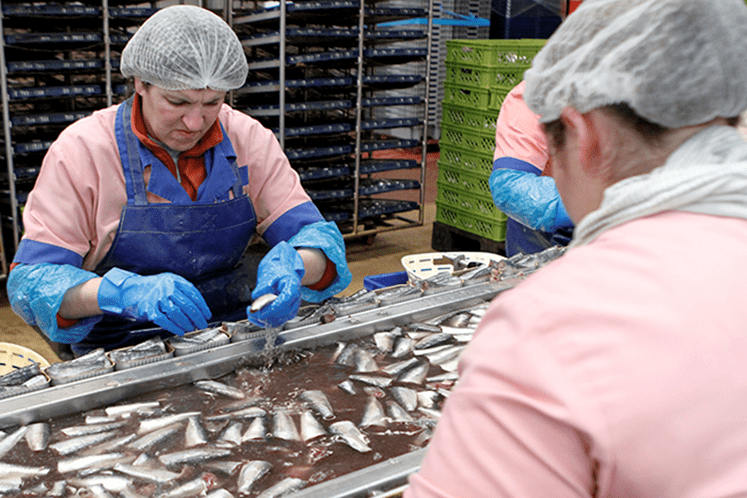
1.3.1 canning Producer in Brazil
According to Embrapa study reveals that in the year 2007 the Brazil was the largest producer and consumer of Palm. The production of Palm was 41,714 tons, brazilian production represents more than 50% of all Palm sold in the world. Due to the 2007 data of the Institute of agricultural economics, the State of Goiás is the largest producer of Palm cultivated in the country; followed by the States of Bahia and São Paulo. Already the largest producer of palmito extracted from nature is the Pará State and in subsequent Santa Catarina and São Paulo (sustainable, 201?).
The Brazil was also the largest exporter of canned hearts of Palm and managed to lose space for the international market by the present low quality Brazilian Palm. From the extraction and not ecological, ravaging native palm trees felled illegally. These statements difficult to be denied on the grounds that the Brazil began consuming and exporting palmito Juçara (Euterpe edulis) originating in the Atlantic today being considered at risk of extinction (sustainable, 201?).
1.3.2 preserved Benefits for humanity
According to Embrapa waste between the fruit and vegetable even when they're in the country accounting for 10%, and indicate that 50% match the losses in transport, to be transported to the target and injured arriving inappropriately crushed, a reduction these wastes would be the production of canned and the deployment of small industries in the field (READ; SILVA, 2013).
According to Miguel (2015), there are many benefits contained in natural preserves, as mentioned below:
- Are excellent Detox agents because, clean the body of a wide variety of toxins;
- Includes higher levels of probiotics;
- Accelerates the absorption of minerals;
- Prevents obesity and diabetes;
- Improves immunity, mood, and mental health;
- Fight infections;
- AIDS in digestion;
- Preserves and maintains its nutrients and properties intact.
1.4 Ingredients
1.4.1 sodium chloride
The most recognized as sodium chloride salt was one of the first antimicrobial agents to be taken advantage of by the primitives on the edge of civilization was also used, more like flavoring than conservative (COULTATE, 2004).
The salt (NaC1) provided the importance in life of man, since the old days as religious symbol, symbol of power and also a bargaining chip. The salt (NaC1) originated the word "salarium" Greek salary payments for soldiers of the Roman Empire were made with salt, more popularly known as white gold (CHEMELLO, 2005).
Sodium chloride has the function of the withdrawal of the amount of water of food through osmosis, decreasing water availability to microorganisms and preventing your growth and microbial activity. Acting also as a natural preservative, but interfering with the final flavor (DIONISYO; MEIRELLES, 20-?).
In addition to being an important preservative he brings his harm health. Excessive intake of sodium chloride is associated with multiple adverse effects to the well-being, high sodium intake and cardiovascular disease, stroke, left ventricular hypertrophy, blood pressure elevation, including other aggravations as stomach neoplasm, calculose, osteoporosis, asthma and obesity (SARNO, 2010).
1.4.2 Acetic Acid
Popularly known as vinegar is the product known a few years ago, their first appearances were 8000 years BC. at this time the vinegar was not aimed at conservation, but a condiment used due the beneficial properties to the human organism, was recommended to treat sores and ulcers, respiratory dysfunctions due to its characteristics disinfectants and anti-inflammatory properties, and also consumed as a drink diluted in water and as medicines (RIZZON; MANEGUZZIO, 2002).
Vinegar is considered a condiment because your job is to assign taste and aroma to food, promoting digestion, because the property comprised in the vinegar promotes gastric juice-sucking thereby increasing solvent action, remembering that everything ingested in excess is bad. Used in cooking all over the world your name comes from the French term "vin agre" meaning sour wine. Becomes sour for having the presence of acetic acid, which is a product of the oxidation of ethanol present in the wine. The acetous fermentation corresponds to transforming the alcohol into acetic acid caused by certain bacteria (LIZ, 200?).
1.4.3 pepper in black bean
The black pepper or black pepper (Figure 3) is one of the most consumed spice in the world, she is originally from India and has been used since the primitives, was so much valued at the time who went on to be used as a bargaining chip for this fact called "black gold". In addition to its medicinal uses, the larger your use was as a condiment for meats and canned (health, 2014).
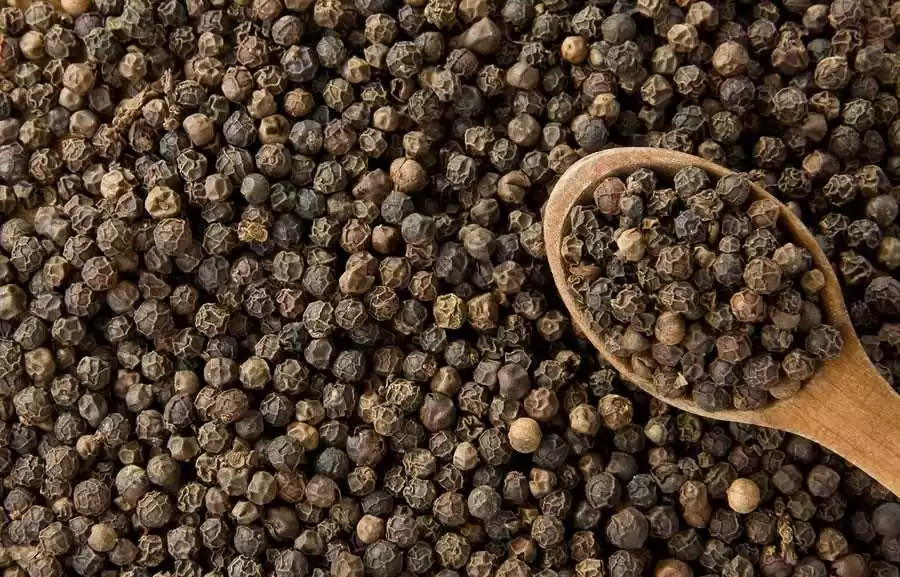
The pepper is produced through unripe fruits harvested, fermented and dried artificially using ovens or in a natural way using the Sun. Can be sold in whole or ground (LINGUANATTO, 2008).
1.4.4 in pepper white grain
Would lead to the same result in the same family "piper nigrum. The white pepper (Figure 4) has many benefits, it has antioxidant action, helps in weight loss, is rich in vitamins A and K, aid digestion, is most often used in dishes that do not allow color change as in the case of white sauce (FRANCO, 200?).
Of course the grains of black pepper in your foot has the Green coloring, and to obtain the white color are subjected to a process that is to bag them and let them immersed in water, about a week or two varying according to the degree of maturation, finally the shells are soft and are easily removed, so they are taken out of the bags are washed and dried in oven or Sun (IBURG, 2005; LINGUANATTO NETO, 2004. Apud ZENCANARO, 2008). The difference between the white and black pepper gives the industrialization process, and your fruit of the same plant (POTSCH, 2009).
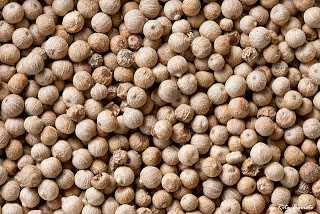
1.4.5 bay leaf
The flavor comes from the Laurel Laurel a source tree in the Mediterranean and may reach 20 metres in height. Its features are in their showy leaves, with odor strongly indicated for the cuisine. Have your fruit is black and can be taken from the Bay oil with medicinal purposes, besides your wood is of excellent quality for commercialization (warehouse, 2013).
Bay leaf is an aromatic leaf, often used in cooking all over the world, being marketed dried has a strong aroma and flavor, are used in the preparation of meats, soups, broths and canned. Has several benefits such as aid in digestion, anti-inflammatory respiratory problems, contains vitamins B, C and D, also are rich in minerals such as calcium, iron, potassium and magnesium (BENEFITS, 2014).
1.4.6 nutmeg
From antiquity to the 19TH century, the nutmeg was found in the Bands in Molucos, Indonesia. They were marketed by Arab merchants the Republic of Venice, and resold for very high prices, because they are hard to find (GEORGE, 2013).
This seed is to Moscadeira tree (Myristica fragans), is a yellowish or reddish fruit, when ripe opens a seed covered by Red fibers, fibers which are called "Mace", which are widely used in the preparation of liqueurs (milk, 201?).
Nutmeg is a very common condiment in cooking in the world, used in hot dishes, baked goods, sauces, salads or preserved. This condiment has outstanding aroma and flavour, and popular medicinal properties that help in the digestive system, detoxification of the liver and kidneys (milk, 201?).
1.5 family Agribusiness
The agricultural sector, especially family agriculture comes from the early 1990, opportunity achieved and recorded soon after the creation of the family agriculture Law n° 11,326 of 24 July 2006 to consider, according to Brazil, (2006).
- Family farmer and entrepreneur rural family that that practice activities in rural areas, using only the labour of his own family;
- Have family income predominantly originated from economic activities linked to the own establishment or undertaking;
- To manage your establishment or enterprise with your family, among several other requirements.
This recognition is the result of several fights fought represented by social movements, trade unions, among others. Family agriculture is an activity that has always been inside of rural life, resulting from your own production of raw materials still in the field, your handmade process agricultural products on domestic and rural cuisine of your Marketing (SULZBACHER, 2009).
Family agribusiness brings with it great progress and benefits to rural areas as for example: turn and/or industrialize the production; add value to the products; improve the income and quality of life of the rural family; professionalize the family farmer, insert and keep it competitively in the market; generate more jobs; permit the marketing directly to the consumer customer. As well as get more recognition and encouragement both in society as in government agencies, because figure still very shy around all society (SHARMA, 201?).
The strategies used in the marketing of each family provide agribusiness somehow to the farmer new sales opportunities, so that he can take advantage of all available resources on the property to enhance or even create new products for the consumer market, in addition to collaborating with the sustainability of natural resources and the decrease of rural exodus, through the use of family labour (BORTOLUZZI, 2013).
1.6 natural food
It has been commonly used the name "natural food" often with varied concepts, because the naturalness of food has many forms.
According to Anvisa, she informs and defines what is "fresh food", all vegetable or animal food for immediate consumption which require only the inedible part removal, following the indicated treatments for your perfect hygiene and preservation (BRAZIL .1969).
According to Rozin et al. (2004), ' natural food technical concept: one that has not changed in any significant way by human contact.
Lifschitz 1997 already apud (CANESQUI, 2005), discovered and analyzed four categories who understand the representations about food: "craft and nature", "good nutrition and fitness physiological and anatomical requirements", "without additives" and "sign of trademark".
Thus one can see that the categories are part of the possibility that "natural" is used as a symbol by the companies in an attempt to attract the attention of the consumer (OLIVEIRA; Malta; LIMA FILHO, 2007).
1.7 industrialized Food
The consumer knows only part of the development of processed foods. Throughout this evolution, the role is to modify the food industries and present in two ways: a it is artificial and another must contain a natural status.
To Hernandez (2005), seek the industries that call "natural" to preserve a connection to food with the nature, to the point of view of the consumer. He points out that this technique still tries to ease the critical strategic consumers do to industrialized products emphasizing the insipid, tasteless, erased among others.
Thus Lambert 1996 apud (HERNANDEZ, 2005) certifies that likely consumers examine the "processed products" as inferior and worse than the "natural" products.
According to Arnaiz (2005), probably the rationale for such a claim is that industrialization led to the loss of "References", that doesn't work that consumers need it. Are perceived as "bad" in processed foods, the resources of chemical additives and ingredients added.
According to the authors mentioned above is of course the opinion and consumer preference, which feels safe in purchasing and consuming a natural food that their nutritional and organoleptic properties remain intact, and that the food industrialized passes a modified image to add additives to obtain a better result.
1.8 Harm promoted by additives
The higher the consumption of processed foods, the higher the intake of chemical additives, it is impossible to predict the toxicity ingested and the effects to the body as a result of the consumption of additives are still searched, some more cases get by allergies, cancer and disturbances in the digestive system (BRAZIL, 2007).
For Oliveira et al. (2006), includes the chemical additives such as flavourings, colorants and sweeteners can cause urticaria, angioedema, bronchospasm and shock in some individuals.
Scientific research carried out has accentuated the importance of feeding for the risk of cancer, pointing out that, some substances including synthetic and natural dyes, present in processed foods may have the effect mutagenic and carcinogenic, which can promote changes in deoxyribonucleic acid (DNA) and possibly tumor formation, this causes several countries prohibit your use, and others kept (ANTUNES; AGUILAR, 2000).
Polonius and Peres (2009), introduces the concern about the health of the adolescent is justified because he was one of the biggest consumers of processed foods.
According to Polonium (2010), the legislation related to the use of chemical additives in food in countries of the European continent and in the United States of America is more rigid than South American countries, it demonstrates that these countries tend to have greater concern about the health risks promoted by additives.
1.9 Clostridium botulinum
The meaning botulism, is used to name the food poisoning caused by Clostridium botulinum, stems from "botulus" means sausage in Latin, due to the involvement of this food in the first outbreaks of botulism (scientifically proven FRANCO et al., 2001). Food-borne botulism is very rare, more in return kills quickly, because it is through a common food source contaminated can expose hundreds of people at the same time contamination (CVE, 2008).
According to Franco et al. (2001), in actuality three forms of botulism are already well known:
- Classic refers to botulism poisoning caused by ingestion of foods containing neurotoxins;
- Botulism from injury is an infectious disease caused by the proliferation and the triggering of toxins in infected lesions by Clostridium botulinum;
- Infant botulism is an infectious disease generated by ingesting spores of Clostridium botulinum and of immediate germination, multiplication in the intestine of children under one year of age.
1.9.1 Foods associated with botulism
Many and various are the foods cited as responsible for botulism, for example embedded canned meats in General (sausage, ham, salami) or preserved canned or glass of sweet, vegetables, vegetables (Palmettos, pickles, peppers), fish and other, mostly packed in vacuum packaging, without oxygen, without proper treatment, the development and proliferation of bacteria and toxin production. Noting that homemade preserves should be handled with the utmost care in preparing and cleaning, following the parameters required by law, do not tend to occur or bring health risks (TRABULSI et al., 1999).
1.9.2 the botulism in Brazil
According to Eduardo et al. (2002), the first outbreak of botulism in Brazil was confirmed in the State of São Paulo in 1990, due to ingestion of homemade pickled pickles badly handled, which featured the botulinum toxin from the bacterium Clostridium botulinum, and the person who has consumed triggered the disease soon after ingestion.
According to Santiago (1972), occurred the first outbreak of botulism in Brazil, took place in 1958, in Rio Grande do Sul, where nine people died after eating contaminated fish, homemade preserves.
Later subsequently between 1997 and 1999, there were three confirmed cases of food-borne botulism caused by intake of preserved Palm getting the toxin type a. From these cases, the ANVISA has designated the labelling of all domestic and foreign products the following warning to consumers: "For your safety boil this product for 15 minutes before being consumed," on the grounds that all the Palm was considered suspect (EDUARDO et al., 2002).
1.10 Main errors from contamination
Contamination of food can occur in three ways, namely, physics, chemistry and biology. Physical contamination stems from the presence of foreign bodies to foods like stones, wood, hair, nails, razor blades, fragments of insects. The chemistry comes from the presence of strange chemicals or toxins produced by microorganisms in foods such as insecticides, detergents, heavy metals, drugs, dyes and additives (non-authorised) among others and the biological is caused by the presence of pathogenic microorganisms in food, such as bacteria, parasites, viruses (hepatitis), poisonous animals (mollusks, fish, mussels) etc. (Hygiene, 2010).
Daily practices are performed without the concentration and knowledge that generate various contaminations in the preparation, and provide a full risk food who ingest, as cited below (hygiene, 2010):
- Food preparation in time before your consumption;
- Prepared food left at ambient temperatures, indoors;
- Bad cooking, causing microorganisms continue present in food;
- Cross-contamination occurs when the same utensil to prepare several other foods;
- Handlers that fail to comply with the GMP amenities (bath, hair tied up and washed, beards made, nail clippings, among others).
1.10.1 how to prevent food contamination
Prevention is the best solution to prevent food contamination, and some care is needed to ensure security in the preparation as (hygiene, 2010):
- Select the good and bad foods is critical;
- Suitable for cooking food;
- Do not defrost food at room temperature;
- Consume immediately after the process of preparation or filling, not to leave exposed to room temperature for a long time;
- Store food properly;
- Reheat the food ready to consume;
- Use treated water of good quality in the preparation;
- Constantly washing your hands while handling the product, keep clean the uniform;
- Keep always clean and well sanitized utensils, equipment, environment, among others;
- Keep food out of the reach of insects and other animals that may contaminate.
2. On-site research
2.1 Preserved gring ' Rio Grande do Sul
The Taquari Valley brings together more than 110 agribusinesses, the highest number in the State. The improvement of production, in addition to estimating the raw material, ensures the succession. In the farm Village New 2177 Fatima Linemann (Figure 5), the popular "Gringa", 43 years old, worked with her husband Behnam Linemann and two sons Linemann and Anderson Linemann Robison, in a family of agroindustry canned vegetables (Valley, 2014).
Five years ago was legalized and rebuilt a new Pavilion to meet sanitary requirements and increasing search market by products. The main production is the cucumbers. Are harvested on average 1.5 ton of the fruit for seven months a year. Other 53 products are processed and sold to markets in the region. The fruits and other vegetables are purchased from other local producers. According to Gringa: "With income guarantee the succession of the business". The search is greater than the supply in some months of the year. Prices vary according to the packaging, cost R $3.00. Robison, 25 years Linemann, AIDS in the production and sales, Anderson Linemann, 24 years, helps his father in farming. As the same claim: "Here we own the business, with quality products and affordable prices, guarantee a good salary a month," says Robison Linemann (Valley, 2014).
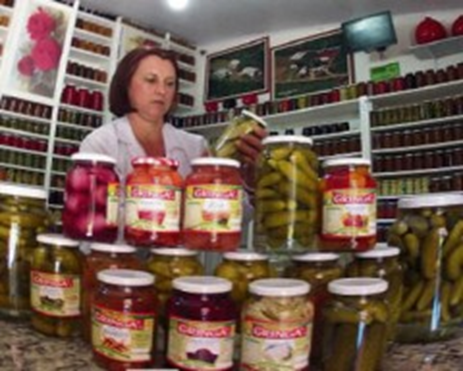
For a few years Linemann, Joa home products produced under the technical guidance, the reconstruction of a new building obtained more quality and kept the amount of products, mainly of cucumber. Between some difficulties, the lack of raw material is the most difficult. With the aid of greenhouses, products like tomatoes, beans, fruits and spices are purchased from other producers (Valley, 2014).
2.2 process of industrialization
At the time it was made the visit, stood around the peach crop, currently on your station. In Figure 6, even cooking with the skin, and the packaging of sugar, where he remained all night cooking.
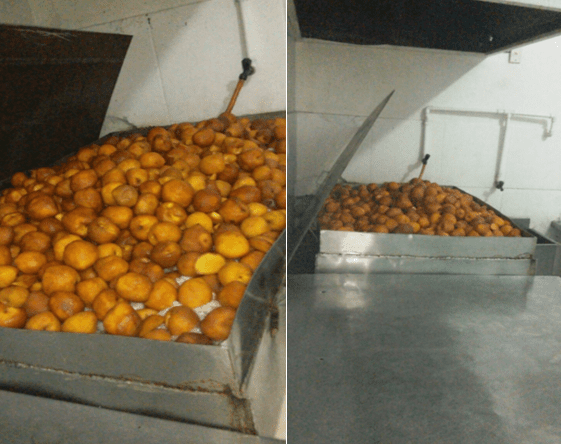
During cooking, in Figure 7 the glasses are in a gallon of water and chlorine solutions to kill pathogenic micro-organisms and partially await in the boxes turned down for the disposal of all the water in the glass. Noting that the hot water process is valid for products with high acidity (pH below 4.5) that helps to prevent against spores of Clostridium Botulinum (botulinum toxin-producing bacteria).
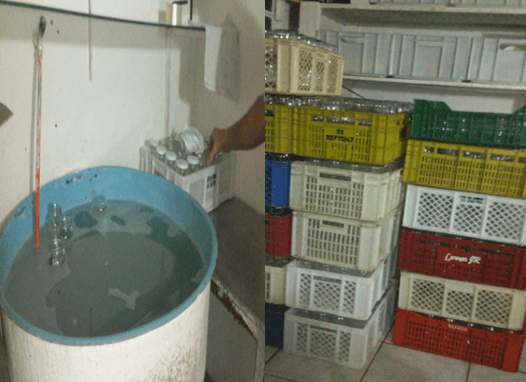
In Figure 8, is a production kitchen, where fruits and vegetables are washed, trimmed, cooked and packed. One should pay attention to the workplace, because some irregularities can cause accidents of employees, and the contamination of food produced and stored, bringing risk to consumers that purchase.
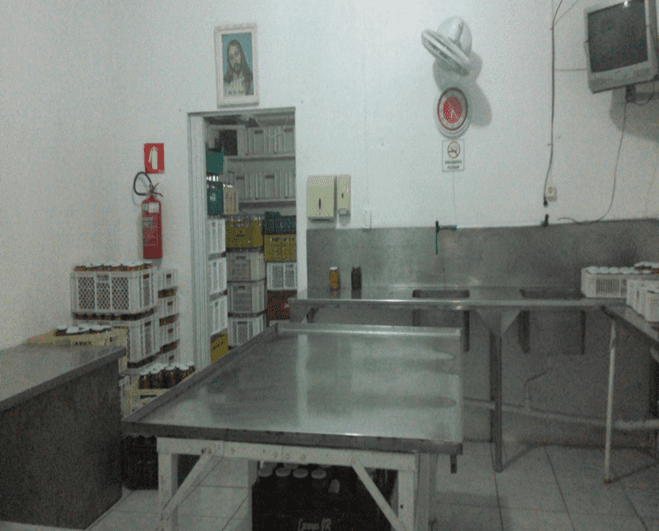
In this figure 9 shows the boiler that produces all the heat for the cooking of peaches. The boiler is on the outside, looks like a wood stove, put the logs in the black door and the fire will burn, and producing heat, which is measured by the thermometer and sent to the kitchen through pipes.
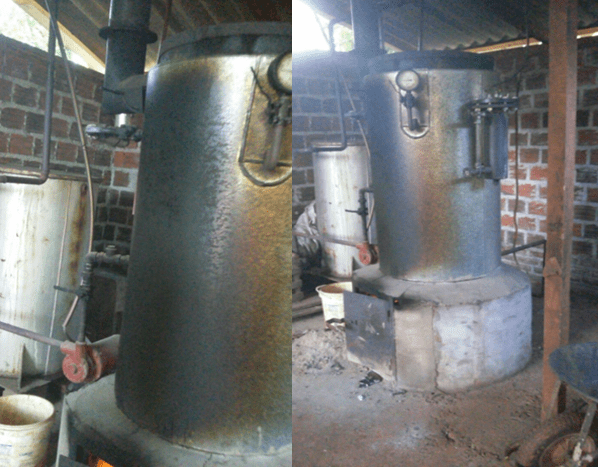
In Figure 10, you can see the final product bottled, passed by pasteurization, stored and waiting to be marketed.
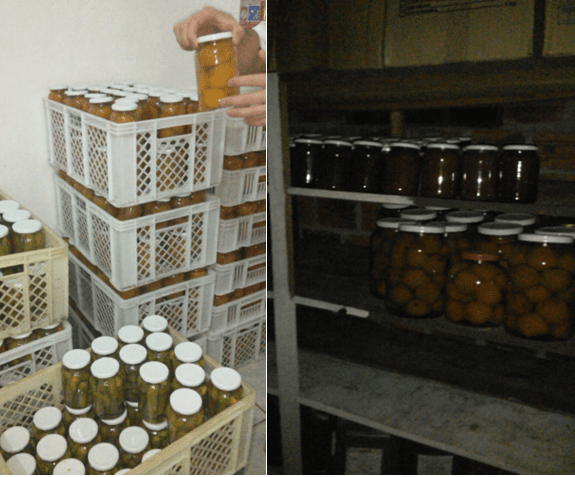
However the Preserved Gring ' is a familiar agro industry, where all help your small business has a good enough monthly income, and a continued growth in society. Are manufactured preserved vegetables and vegetables as cucumbers, onions, broccoli, cabbage, potatoes, chilies, peppers, tomato, beetroot, quail egg, there are preserves of peach, guava, Apple, grapes and many other varieties. The small company even works with Exchange system, where every empty bottle taken to return, the consumer WINS R $0.50 cents discount on the purchase of another.
Conclusion
The present research was designed to inform more clearly what is preserved in natura that basically is to preserve food for longer keeping its original features, including their conservation methods aimed at destroying and inhibiting the growth of microorganisms that can degrade or alter the product, in addition to several health benefits, the preserve also brings a harmful side that when not manufactured properly at appropriate temperatures, and may contain some types of bacteria as Clostridium botulinum which can lead to death.
With the on-the-spot research you can better visualize and understand how the whole process is conducted on a large scale, preserve this process that is different from what we do at home, where you don't have all the proper care with hygiene, quantity and ingredients as it is manufactured by hand, often only for the own consumption. And it can also know how the structure and functionality of a small company.
Preserved Gring ' are based on a family of small agro, where they plant and harvest their own raw materials as well as acquire local producers are not required to hire external collaborators, because all of the family work in the field as in the preparation and marketing of its products, taking a net income at the end of the month and keeping a daily coexistence between them. The small company still has no subsidiaries and also resells its products to markets in the region, it is situated in a municipality named Vila Nova, but that attract consumers from every corner of Rio Grande do Sul.
An important aspect in this research was to identify the food waste during the manufacturing process, because their major losses are still in the field after harvest, and in your transportation, lack of knowledge and producers ' investments, the implementation of a cooperative and/or small businesses installed directly in the field would be the solution to minimize these losses, and turning into products packaged and ready for marketing, and can be distributed to other regions.
It is concluded that since your discovery and your improvement, saves space on the market, which gained acceptance keeps growing. In this scenario of canning, agribusiness way shy figure family, which should be different, because the final product retains its nutritional values and organoleptic properties intact. The recognition is your little valued, and this is directly related to the choice of the final consumer, who opts for natural because you know that the product has been produced in the field for farmers and their families, with no industrialization. Anyway, it's an area that lacks investments and incentives for your expansion and development.
References
Food. Methods of preserving food. 2015. Available at: <http: www.quimicalimentar.com.br/metodos-de-conservacao-de-alimentos/="">accessed: 19 of Jul of 2016.</http:>
ANTUNES, L. M. G.; AGUILAR, m. c. p. Apud BISSACOTTI a. p. implications of chemical additives in consumer health. 2000. Available at: <http: sites.unifra.br/portals/36/csaude/2015%20-%201/06%20-%20284%20implica%e2%82%ac%c3%a5es%20dos%20aditivos%20qu%c3%96micos.pdf="">accessed: 21 may 2016.</http:>
WAREHOUSE. Spice: Laurel. 2013. Available at: <http: armazemdasespeciarias.com.br/2013/02/20/especiaria-louro/="">accessed: 19 of Jul of 2016.</http:>
ARNAIZ, m. g. towards a new order. Apud CANESQUI, A. M.; DIEZ G, r. w. (org.). Anthropology and nutrition: a dialogue possible. Rio de Janeiro. 2005. Editora FIOCRUZ.
BENEFITS. The benefits of bay leaf 12 to health. 2014. Available at: <http: www.saudedica.com.br/folha-de-louro/="">accessed: 19 of Jul of 2016.</http:>
BARRIOS, v. history of the preserves. 201. Available at: <http: correiogourmand.com.br/info_01_cultura_gastronomica_01_11.htm="">accessed: 11 Apr from 2016.</http:>
Brazil. ANVISA. National health surveillance agency. ATC resolution n° 05, October 1979. Establishing these standards, which are intended to establish the identity and the minimum quality characteristics which must obey the canned fruits. Brasília-DF. 1976. Available at: <http: www.anvisa.gov.br/anvisalegis/resol/05_79.htm="">accessed: 01. of 2016.</http:>
Brazil. DECREE-law No. 986, of 21 October 1969. Establishes basic rules on food. Official Gazette, Brasilia. Available at: <http: www2.camara.leg.br/legin/fed/declei/1960-1969/decreto-lei-986-21-outubro-1969-377556-norma-pe.html="">accessed: 11 Apr from 2016.</http:>
Brazil. Law No. 11,326, of 24 JULY 2006. Establishes the guidelines for the formulation of the national policy of family farming and Rural Family Ventures. Available: <https: www.planalto.gov.br/ccivil_03/_ato2004-2006/2006/lei/l11326.htm="">accessed: Oct 26.</https:> of 2016
Brazil. Ministry of education. Secretariat of basic education. Module 11: healthy and sustainable. Brasilia: Universidade de Brasília. 2007.
BORTOLUZZI, D. L. family rural Agroindustry and economic development. Horizontina. 2013. Available at: <http: www.fahor.com.br/publicacoes/tfc/economia/2013/eco_dinara.pdf="">accessed: Oct 26.</http:> of 2016
LIFSCHITZ. Apud CANESQUI, A. M.; DIEZ g. r. w. (eds.). Anthropology and nutrition: a dialogue possible. Rio de Janeiro. 2005. Editora FIOCRUZ.
CHEMELLO, AND. Chemistry in the kitchen presents: the salt. Magazine: ZOOM. Publisher: Cia school. Year 6, nº 3 São Paulo SP. 2005.
LAMB, p. Preserved: Ramirez, the oldest factory in the world. 2014. Available at: <http: www.revistamacau.com/2014/08/20/ramirez-a-mais-antiga-fabrica-de-conservas-do-mundo/="">accessed: 07 Jun from 2016.</http:>
COULTATE. T. p. Food: the chemistry of its components. New Haven. 3° ed. Porto Alegre: p. 77-251. 2004.
CVE. Epidemiological Monitoring Centre – Manual of botulism. 2008. Available at: <http: www.cve.saude.sp.gov.br="" –="">accessed: 21 may 2016.</http:>
DIONISYO, r. b., MANNING f. v. p. preserving food. 201. Available at: <http: web.ccead.pucrio.br/condigital/mvsl/sala%20de%20leitura/conteudos/sl_conservacao_de_alimentos.pdf="">accessed: 20. of 2016.</http:>
Edward m. b. p. et al., 2002. Apud PARRILLI c. c. Clostridium botulinum in foods. São Paulo, 2008. Available at: <http: arquivo.fmu.br/prodisc/medvet/ccp.pdf="">accessed: 22 may 2016.</http:>
FRANCO, b. d. g. m. et al. Microbiology of food. v. 2, Publisher Atheneu, p. 139-145. São Paulo. 2001. Access in: 21 may 2016.
FRANCO, l. l. Meet the black pepper. 201. Available at: <http: nossamelhoridade.com.br/artigos/artigosver.php?artigoid="8490&capa_canalID=26">accessed: 19 of Jul of 2016.</http:>
FURASTÉ, p. a. technical standards for scientific work: Explicit of the ABNT. 17 ed. Porto Alegre: Dactyl Plus, 2014.
Global. Magazine: Portugal. 2013. Available at: <http: www.portugalglobal.pt/pt/portugalnews/documents/revistas_pdfs/portugalglobal_n59.pdf="">accessed: 06 of June of 2016.</http:>
GEORGE, m. 5 Spices used in maritime expansion. 2013. Available at: <http: www.historiadigital.org/curiosidades/5-especiarias-usadas-durante-a-expansao-maritima/="">accessed: 19 of Jul of 2016.</http:>
HERNÁNDEZ, j. c. heritage and globalization: the case of food crops. Apud CANESQUI AM, Garcia RWD. Anthropology and Nutrition: a dialogue possible. Rio de Janeiro. 2005. p. 129-145
Hygiene. Hygiene, storing and preserving food. Belo Horizonte. 2010. Available at: <http: www.pbh.gov.br/smaab/cartilhas/cartilha_higiene_e_conservacao_dos_alimentos.pdf="">accessed: 06 of June of 2016.</http:>
IBURG, 2005; LINGUANATTO GRANDSON. 2004. Apud ZENCANARO. Peppers: types, use in cooking, and functions in the body. Brasilia. 2008. Available at: <http: bdm.unb.br/bitstream/10483/361/1/2008_raqueldaneliczenzancanaro.pdf="">accessed: 11 Apr from 2016.</http:>
KROLOW, a. c. r. pickled Vegetables: Embrapa information technology. Brasília-DF. 2006. Available at: <https: www.infoteca.cnptia.embrapa.br/bitstream/doc/865179/1/00078030.pdf="">accessed: 01. of 2016.</https:>
Milk, P. 10 benefits of nutmeg: what use and properties. 201. Available at: <http: www.mundoboaforma.com.br/10-beneficios-da-noz-moscada-para-que-serve-e-propriedades/="">accessed: 19 of Jul of 2016.</http:>
LEMOS, F.; SILVA, a. how and why avoid wasting. 2013. Available at: <http: planetasustentavel.abril.com.br/noticia/lixo/como-evitar-desperdicio-seguranca-alimentar-bons-fluidos-752309.shtml="">accessed: 03 of Aug.</http:> from 2016.
Lemos, p. Preserved: Ramirez, the oldest factory in the world. 2014. Available at: <http: www.revistamacau.com/2014/08/20/ramirez-a-mais-antiga-fabrica-de-conservas-do-mundo/="">accessed: 07 Jun from 2016.</http:>
LINGUANATTO NETO, no gastronomic Dictionary of peppers
with your recipes. 2008. Available at: <http: bdm.unb.br/bitstream/10483/361/1/2008_raqueldaneliczenzancanaro.pdf="">accessed: 19 of Jul of 2016.</http:>
LIZ, e. wine vinegar. 201. Available at: <https: erikalizfarma.files.wordpress.com/2010/11/vinagres-de-vinhos1.pdf="">accessed: 26. of 2016.</https:>
LEE, a. Industrialization values the product and ensures success. 2014. Available at: <http: www.cicvaledotaquari.com.br/portal/index.php/industrializacao-valoriza-o-produto-e-garante-sucesso/="">accessed: 05 of Aug.</http:> from 2016.
MANNING, A. The preservation of food and innovative pastry. 201. Available at: <http: www.ablv.org.br/listcontentint.aspx?id="365">accessed: 09 Jun from 2016.</http:>
MIGUEL, d. natural Preserves and its benefits to immunity. 2015. Available at: <http: www.deliyou.com.br/blog/conservas-naturais-e-seus-beneficios-para-imunidade/="">accessed: 04 of Aug.</http:> from 2016.
OLIVEIRA, c. h. et al. Apud BISSACOTTI a. p. implications of chemical additives in consumer health. 2006. Available at: <http: sites.unifra.br/portals/36/csaude/2015%20%201/06%20%20284%20implica%e2%82%ac%c3%a5es%20dos%20aditivos%20qu%c3%96micos.pdf="">accessed: 21 may 2016.</http:>
OLIVEIRA, V. R.; MALTA, M. C. M.; LIMA FILHO, d. Concept of natural food and industrialized food: a social and behavioral approach. Paraná. 2007. Available at: <http: www.abepro.org.br/biblioteca/enegep2007_tr610460_9791.pdf="">accessed: 21 may 2016.</http:>
PALMEIRA, l. Ramirez wants to open new plant in April or may 2015. 2014. Available at: <http: www.leca-palmeira.com/ramirez-quer-abrir-nova-fabrica-em-abril-ou-maio-de-2015/#.v_pdiearliu="">accessed: 06 Jul from 2016.</http:>
POLONIUS, M. L. T., 2010. Apud BISSACOTTI a. p. implications of chemical additives in consumer health. 2014. Available at: <http: sites.unifra.br/portals/36/csaude/2015%20-%201/06%20-%20284%20implica%e2%82%ac%c3%a5es%20dos%20aditivos%20qu%c3%96micos.pdf="">accessed: 21 may 2016.</http:>
POLONIUS, M. L. T.; PERES, f., 2009. Apud BISSACOTTI a. p. implications of chemical additives in consumer health. 2014. Available at: <http: sites.unifra.br/portals/36/csaude/2015%20-%201/06%20-%20284%20implica%e2%82%ac%c3%a5es%20dos%20aditivos%20qu%c3%96micos.pdf="">accessed: 21 may 2016.</http:>
POTSCH,. Various colors of pepper and its uses. 2009. Available at: <http: www.aromasesabores.com/2009/06/as-varias-cores-da-pimenta-do-reino-e.html="">accessed: 19 of Jul of 2016.</http:>
RIZZON L. A.; MARISENI j. preparation of vinegar. 2002. EMBRAPA grape and wine. Bento Gonçalves-RS. 2001. Available at: <https: www.agencia.cnptia.embrapa.br/repositorio/doc36_000fqzj72ov02wyiv80084arl8no17pt.pdf="">accessed: 25 de Mar from 2016.</https:>
ROZIN, P.; SPRANCA, M.; KRIEGUER, Z.; NEUHAUS, R.; SURILLO, D.; SWERDLIN, A.; WOOD, k. Preference is natural: instrumental an ideational/moral motivations, and the contrast between foods and medicines. Appetite, v. 43, p. 147-54, 2004.
SARNO, f. estimates of sodium consumption in Brazil, review the benefits related to the consumption of this nutrient limitation in metabolic syndrome and intervention impact assessment in the workplace. 2010. Available at: <https: www.google.com.br/url?sa="t&rct=j&q=&esrc=s&source=web&cd=7&cad=rja&uact=8&ved=0ahUKEwjn7anGsc_LAhVGCpAKHWJhASYQFghDMAY&url=http%3A%2F%2Fwww.teses.usp.br%2Fteses%2Fdisponiveis%2F6%2F6138%2Ftde-09102010-183930%2Fpublico%2FTese_Flavio_Sarno.pdf&usg=AFQjCNG4zi1tTbnr5z8rlRNqnWaZZi_b_w&bvm=bv.117218890,d.Y2I">accessed: 20. of 2016.</https:>
SANTIAGO, o. et al. Apud PARRILLI c. c. Clostridium botulinum in foods. São Paulo. 1972. Available at: <http: arquivo.fmu.br/prodisc/medvet/ccp.pdf="">accessed: 22 may 2016.</http:>
Health. The 8 benefits of black pepper. 2014. Available at: <http: www.saudedica.com.br/os-8-beneficios-da-pimenta-do-reino-para-saude/="">accessed: 19 of Jul of 2016.</http:>
SHARMA, j. n. family of Paraná: agroindustry Project factory of the farmer. Curitiba. 201. Available at: <http: www.emater.pr.gov.br/modules/conteudo/conteudo.php?conteudo="81">accessed: Oct 26.</http:> from 2016.
SULZBACHER, a. w. family rural Agroindustry: paths to estimate social impacts. São Paulo. 2009. Available at: <http: www.geografia.fflch.usp.br/inferior/laboratorios/agraria/anais%20xixenga/artigos/sulzbacher_aw.pdf="">accessed: Oct 26.</http:> from 2016.
Sustainable. Palm heart production. 201. Available at: <http: www.ambiente.sp.gov.br/palmitosustentavel/producao/="">accessed: 14 Jun from 2016.</http:>
SEASONINGS. Spices that more use. 2013. Available at: <http: reinodemorango.blogspot.com.br/2013/07/temperos-que-mais-uso.html="">accessed: 19 of Jul of 2016.</http:>
TRABULSI L.R.; ALTERTHUM F.; GOMPERTZ. F.; CAMPOS j. a. n., et al. 1999. Apud PARRILLI Dc Clostridium botulinum in foods. São Paulo-Sp. 2008. Available at: <http: arquivo.fmu.br/prodisc/medvet/ccp.pdf="">accessed: 22 may 2016.</http:>
Valley. Industrialization values the product and ensures success. 2014. Available at: <http: www.cicvaledotaquari.com.br/portal/index.php/industrializacao-valoriza-o-produto-e-garante-sucesso/="">accessed: 05 of Aug.</http:> from 2016.
[1] Monograph submitted to the Technical course in food, the Escola Estadual José Ribeiro Appeared under the guidance of Professor Andréia Cardoso Ali Barlas as a requirement for obtaining the title of technician in food.
[2] Food technician

